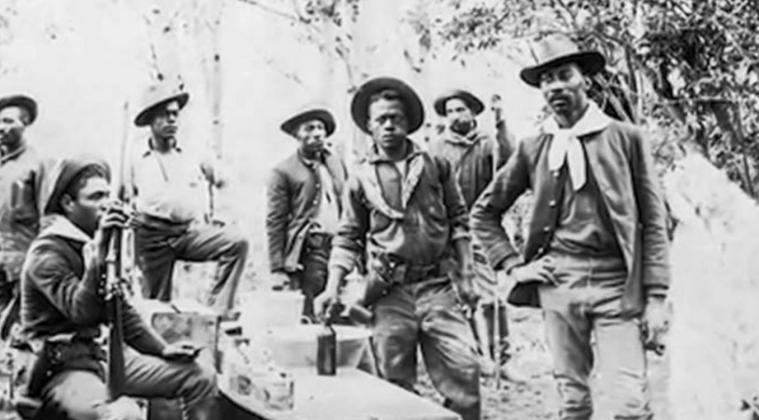Black History Month: Black Jack Pershing and the Buffalo Soldiers
Sitting high on a wall in the Frontier Times Museum is a large portrait of a very distinguished looking military man, General “Black Jack” Pershing. Found in a junk shop in San Antonio, it was one of the first items to be donated to the museum after its opening in May of 1933.
At the time it was painted, General Pershing was a national celebrity known for his many military exploits at the turn of the last century when the United States was just beginning to exert its influence on the international stage. He is also known as the commander of a distinguished Black Army unit that changed the course of our national history.
Trained at West Point in the 1880s, John J. Pershing was always proud to call himself a “son of the West.” Known as an excellent horseman, he was well-suited for his tour of duty in the forts that were established to tame the western frontier. It is believed he earned his moniker, Black Jack, when he was assigned to the 10th Cavalry, a crack regiment of Black troops that was formed after the Civil War in 1866.
While free African Americans fought in the Union Army during the war, Congress had to pass new legislation to allow African Americans to enlist in the regular peacetime military. Among the Black regiments that were established was the 10th Calvary who were tasked with assisting in the subjugation of the American Indians, capturing cattle rustlers and protecting settlers, travelers, and the railroad from outlaws and bandits.
The troops became known as “Buffalo Soldiers,” a nickname given to them by the American Plains Indians because their dark, curly hair resembled a buffalo’s coat and because the Indians were impressed with how tough the soldiers were in battle. The soldiers felt the name was given to them out of respect and even incorporated a buffalo in their regiment’s coat of arms.
After the end of the American-Indian Wars, the Buffalo Soldiers continued to prove their military strength as the United States entered into battles on foreign soil. When war was declared against Spain in April of 1898, General Pershing went with his Buffalo Soldiers to fight in Cuba. While Teddy Roosevelt and his Rough Riders are best remembered for their exploits during the Spanish American War, both Black and White regiments gallantly fought side by side.
The battle of San Juan Hill was particularly difficult as they found themselves fighting as foot soldiers, dismounted from their horses. The 10th Cavalry suffered numerous casualties, losing half of its officers and 20 percent of its troops.
In Pershing’s own words, “Through streams, tall grasses, tropical undergrowth, regardless of casualties, this gallant advance was made.”
When the hill was finally taken, Pershing described the carnage, “… the wounded on both sides were cared for alike. One colored trooper stopped at a trench filled with Spanish dead and wounded and gently raised the head of a Spanish lieutenant and gave him the last drop of water in his canteen,” showing honor among men knows no boundaries.
By 1914, Pershing was sent to El Paso to defend the borders of Texas with Mexico during the Mexican Revolution. Mexico was in a state of turmoil as Venustiano Carranza and Pancho Villa struggled for control of the government after the ouster of dictator Porfirio Diaz.
The United States favored Carranza, which infuriated Villa. Pershing was ordered to organize an expedition into Mexico to defeat Villa. The Buffalo Soldiers of the 10th Calvary were among the 6,600 soldiers sent. After fierce fighting, President Woodrow Wilson, not wanting war with Mexico, called back the troops.
It would be the last time the 10th Calvary would perform as a horse cavalry against an enemy. In 1948, President Harry Truman issued an executive order eliminating the military’s racial segregation and all Black units were disbanded.
The oldest living Buffalo Soldier, Mark Matthews, died at the age of 111 in 2005, but the history of the Buffalo Soldier still lives on through historical reenactments and at the Buffalo Soldiers National Museum in Houston.
There is irony to be found in their legacy in that as a group of formerly enslaved people, the Buffalo Soldiers fought against the American Indians, another oppressed people, in a push to take away their tribal land for white settlers. Nevertheless, their bravery and service to their country cannot be denied.
As one of General Pershing’s officers wrote in 1918, “We officers of the 10th Cavalry have taken our black heroes in our arms. They had again fought their way into our affections as they here had fought their way into the hearts of the American people.”
Rebecca Huffstutler Norton is the Executive Director of the Frontier times Museum

